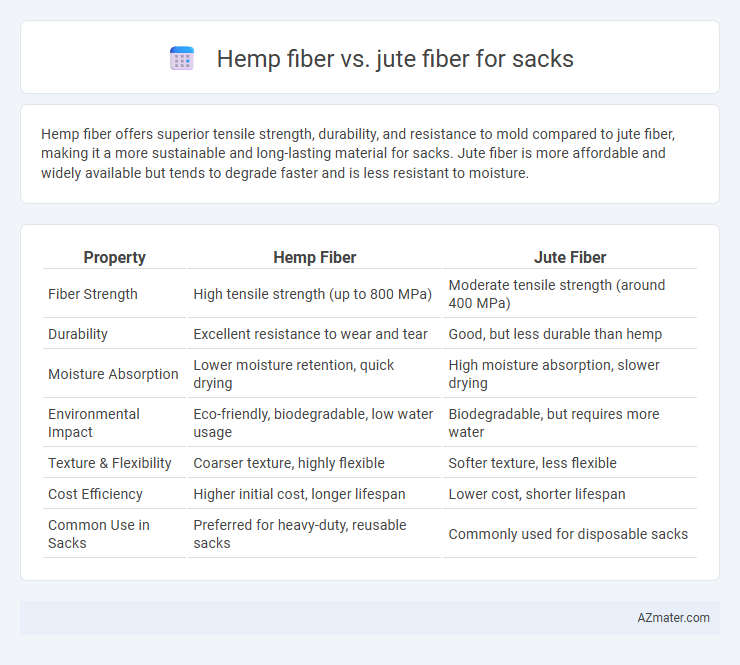Hemp fiber offers superior tensile strength, durability, and resistance to mold compared to jute fiber, making it a more sustainable and long-lasting material for sacks. Jute fiber is more affordable and widely available but tends to degrade faster and is less resistant to moisture.
Table of Comparison
| Property | Hemp Fiber | Jute Fiber |
|---|---|---|
| Fiber Strength | High tensile strength (up to 800 MPa) | Moderate tensile strength (around 400 MPa) |
| Durability | Excellent resistance to wear and tear | Good, but less durable than hemp |
| Moisture Absorption | Lower moisture retention, quick drying | High moisture absorption, slower drying |
| Environmental Impact | Eco-friendly, biodegradable, low water usage | Biodegradable, but requires more water |
| Texture & Flexibility | Coarser texture, highly flexible | Softer texture, less flexible |
| Cost Efficiency | Higher initial cost, longer lifespan | Lower cost, shorter lifespan |
| Common Use in Sacks | Preferred for heavy-duty, reusable sacks | Commonly used for disposable sacks |
Introduction to Hemp and Jute Fibers
Hemp fiber, derived from the stalks of the Cannabis sativa plant, is known for its exceptional strength, durability, and resistance to mold, making it highly suitable for heavy-duty sacks. Jute fiber, obtained from the stems of the Corchorus plant, is appreciated for its affordability, biodegradability, and softness, commonly used in lightweight sacks and packaging. Both fibers are natural, sustainable options with distinct properties tailored to different sack applications in agriculture and industry.
Historical Uses of Hemp and Jute in Sack Production
Hemp fiber has been historically preferred for sack production due to its superior durability and resistance to moisture, dating back to ancient civilizations where it was widely used for heavy-duty bags in maritime and agricultural industries. Jute fiber, originating primarily from the Indian subcontinent, gained prominence in the 19th century as an affordable, biodegradable alternative especially suited for lightweight sacks used in packaging agricultural products like grains and coffee. Both fibers played crucial roles in global trade and storage solutions, with hemp known for enhancing sack longevity and jute valued for its cost-effectiveness and eco-friendly properties.
Physical Properties Comparison: Hemp vs Jute
Hemp fiber exhibits superior tensile strength and durability compared to jute fiber, making it more resistant to wear and tear in sack applications. Hemp fibers are coarser and longer, providing better abrasion resistance and moisture-wicking properties than jute fibers, which are shorter and less robust. The higher lignin content in jute results in lower flexibility and reduced longevity compared to hemp, making hemp fiber sacks more suitable for heavy-duty use.
Durability and Strength of Hemp vs Jute Sacks
Hemp fiber sacks exhibit superior durability and tensile strength compared to jute fiber sacks, making them more resistant to wear and tear under heavy loads. Hemp fibers have a higher cellulose content and longer fiber length, contributing to enhanced mechanical properties and longevity in sacks. Jute sacks, while cost-effective, typically degrade faster and have lower resistance to moisture and abrasion than hemp sacks.
Environmental Impact: Sustainability of Hemp and Jute
Hemp fiber demonstrates superior sustainability due to its rapid growth rate, requiring minimal pesticides and water, which significantly reduces its environmental footprint compared to jute. Jute cultivation emits higher carbon dioxide levels and depends heavily on chemical fertilizers, impacting soil health and biodiversity more adversely. Both fibers are biodegradable, but hemp's lower resource demand makes it a more eco-friendly choice for sack production.
Cost Analysis: Hemp Fiber Sacks vs Jute Fiber Sacks
Hemp fiber sacks typically cost more upfront than jute fiber sacks due to higher cultivation and processing expenses, but they offer greater durability and longer lifespan, reducing replacement frequency and long-term costs. Jute fiber sacks are more affordable initially, favored for low-cost packaging, but may require more frequent replacement because of lower tensile strength and moisture resistance. Evaluating the total cost of ownership, hemp fiber sacks provide better value in applications requiring durability and repeated use, while jute remains economical for short-term, disposable packaging needs.
Moisture Resistance and Breathability in Sack Applications
Hemp fiber exhibits superior moisture resistance compared to jute fiber, making it more effective in preventing dampness and mold growth in sack applications. Both fibers offer excellent breathability, but hemp's natural antifungal properties enhance its performance in maintaining sack contents' freshness. These characteristics make hemp fiber a preferred choice for sacks used in humid or moisture-prone environments.
Processing and Manufacturing Differences
Hemp fiber undergoes a more complex processing sequence involving retting, decortication, and scutching to separate long bast fibers, resulting in higher tensile strength and durability for sack manufacturing. Jute fiber processing relies heavily on water retting followed by mechanical stripping, which is less time-intensive but produces shorter, coarser fibers ideal for economical sack production. Manufacturing with hemp demands advanced machinery for fiber alignment and spinning, whereas jute adapts well to simpler, traditional methods, influencing cost-effectiveness and final product texture in the sack industry.
Market Availability and Global Demand
Hemp fiber and jute fiber are widely used in sack production, with jute dominating the global market due to its abundant cultivation in India and Bangladesh, accounting for over 70% of global supply. Hemp fiber, valued for its superior strength and durability, is gaining demand in eco-friendly packaging markets, especially in Europe and North America, where sustainable products are increasingly preferred. Market availability of jute remains stable and cost-effective, while hemp's supply is expanding slowly due to regulatory restrictions and higher production costs, influencing regional demand and price dynamics.
Choosing the Best Fiber for Sack Production
Hemp fiber offers superior strength, durability, and resistance to pests and rot compared to jute fiber, making it an excellent choice for heavy-duty sack production. Jute fiber, while more affordable and widely available, has lower tensile strength and degrades faster in moist environments. Choosing hemp fiber for sacks enhances product longevity and sustainability, crucial for industries requiring reliable and eco-friendly packaging solutions.

Infographic: Hemp fiber vs Jute fiber for Sack
 azmater.com
azmater.com